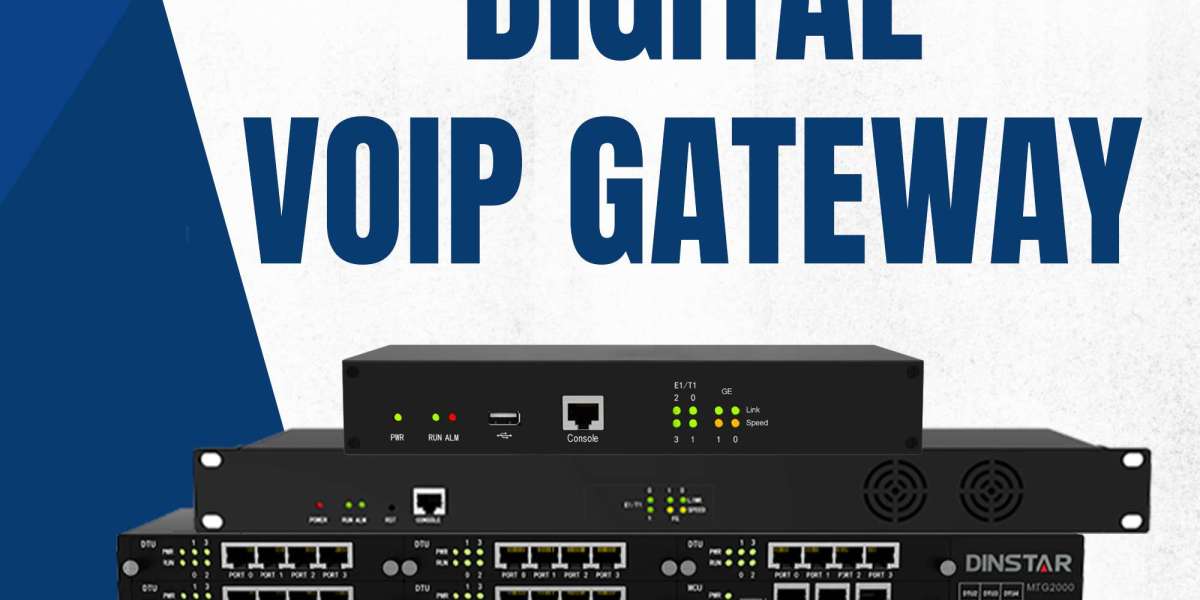A Digital VoIP Gateway is a hardware device or software application that converts voice calls between Public Switched Telephone Network (PSTN) and Voice over IP (VoIP) networks. It supports digital signal formats, usually through E1/T1 or ISDN PRI interfaces, and is widely used in businesses that rely on digital trunk lines for call connectivity.
Unlike analog gateways that deal with FXS or FXO lines, digital gateways handle a larger volume of simultaneous calls, making them ideal for medium to large enterprises, call centers, and telecom carriers.
Key Features of Digital VoIP Gateway
- High Call Capacity
- Supports multiple E1/T1 lines to manage hundreds of concurrent calls efficiently.
- Protocol Compatibility
- Compatible with SIP, H.323, and other VoIP protocols to ensure smooth interoperation with IP PBXs and softswitches.
- Codec Support
- Supports multiple voice codecs including G.711, G.729, and G.723 to optimize call quality and bandwidth usage.
- Redundancy and Failover
- Many gateways support dual power supply and network failover to ensure 24/7 uptime.
- Secure Communication
- When integrated with an SBC (Session Border Controller), the gateway adds a strong security layer to prevent toll fraud, DDoS attacks, and unauthorized access.
How Does a Digital VoIP Gateway Work?
A Digital VoIP Gateway connects to the traditional phone network using digital trunk interfaces like E1 or T1 lines. It simultaneously connects to your VoIP network using Ethernet. When a call comes in from the PSTN, the gateway converts it into VoIP format and routes it over the IP network, and vice versa for outgoing calls.
For example, a business using an ISDN PRI line can deploy a Digital VoIP Gateway to convert incoming PSTN calls into SIP, allowing them to be handled by a modern IP PBX system. This hybrid approach lets companies upgrade their systems without a complete overhaul.
Benefits of Using a Digital VoIP Gateway
1. Cost-Effective Transition
One of the biggest advantages of a Digital VoIP Gateway is that it enables a gradual transition to VoIP. Businesses can retain their legacy equipment while enjoying the benefits of IP telephony.
2. Enhanced Scalability
Need more call volume or new branches? Digital VoIP Gateways allow easy expansion by adding additional ports or units.
3. Improved Call Quality
With support for high-quality codecs and QoS (Quality of Service), digital gateways ensure clear and consistent voice transmission.
4. Centralized Communication Management
All calls—whether analog, digital, or IP—can be routed through a unified platform, simplifying administration and troubleshooting.
5. Strong Security When Paired with SBC
Digital VoIP Gateways, when integrated with SBCs (Session Border Controllers), can secure voice traffic at the network edge. SBCs help monitor, encrypt, and control call sessions, ensuring data integrity and protection from external threats.
The Role of SBC (Session Border Controller)
A Session Border Controller (SBC) is a network element used to manage and protect VoIP traffic. It operates at the edge of VoIP networks and offers functions such as:
- Traffic Routing
- Network Topology Hiding
- Encryption
- NAT Traversal
- Call Admission Control
- DDoS Protection
In a VoIP setup using a Digital VoIP Gateway, an SBC ensures that all voice communication is secure and optimized. It protects the gateway and internal network from threats, handles SIP signaling, and enables seamless interoperability between carriers and IP PBX systems.
Use Cases of Digital VoIP Gateway
- Enterprise PBX Integration: Connecting legacy PBX systems to VoIP trunks.
- Contact Centers: Managing high volumes of inbound and outbound calls.
- Telecom Carriers: Routing PSTN traffic through IP backbone networks.
- Disaster Recovery: Providing alternate routing during network outages.
Choosing the Right Digital VoIP Gateway
When selecting a Digital VoIP Gateway, consider the following:
- Number of E1/T1 Ports Required
- Choose based on current and future call capacity needs.
- Protocol Support
- Ensure SIP support and compatibility with your SBC or softswitch.
- Codec and Voice Quality
- Look for G.729 and QoS features for bandwidth optimization.
- Security Features
- Support for SRTP, TLS, and smooth integration with SBCs for maximum protection.
- Brand Reliability
- Go for established manufacturers known for support and firmware upgrades.
Final Thoughts
A Digital VoIP Gateway is more than just a bridge between legacy and IP networks—it’s a strategic enabler for modern communication. When paired with a Session Border Controller (SBC), it becomes a secure, scalable, and high-performance solution for businesses looking to modernize without compromising reliability or quality.








